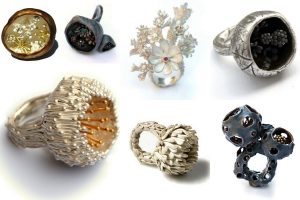 When you’re drawn to nature-inspired jewelry, you’ll discover a fascinating intersection of organic beauty and metalwork mastery. Today’s artisans don’t just replicate leaves and flowers—they capture nature’s essence through innovative techniques that transform precious metals and gemstones into wearable sculptures. Whether it’s the fluid movement of a hand-carved silver branch or the precise geometry of a digitally modeled petal, each piece tells a story of evolution in both design and craftsmanship. As the boundaries between traditional metalsmithing and modern technology continue to blur, the possibilities for capturing nature’s intricate details have become virtually limitless.
When you’re drawn to nature-inspired jewelry, you’ll discover a fascinating intersection of organic beauty and metalwork mastery. Today’s artisans don’t just replicate leaves and flowers—they capture nature’s essence through innovative techniques that transform precious metals and gemstones into wearable sculptures. Whether it’s the fluid movement of a hand-carved silver branch or the precise geometry of a digitally modeled petal, each piece tells a story of evolution in both design and craftsmanship. As the boundaries between traditional metalsmithing and modern technology continue to blur, the possibilities for capturing nature’s intricate details have become virtually limitless.
Botanical Elements in Modern Jewelry
Delicate petals and unfurling ferns have inspired a renaissance in contemporary jewelry design. You’ll find meticulously crafted leaves wrapping around fingers in sterling silver bands, while orchid forms cascade from earlobes in rose gold. Today’s botanical jewelry captures nature’s intricate details through advanced metalworking techniques, transforming familiar garden elements into wearable sculptures that honor the perfection of organic forms.
The Art of Lost-Wax Casting
One of the most revered methods for transforming botanical visions into metal reality is lost-wax casting, an ancient technique that’s found new life in contemporary jewelry making.
You’ll begin by carving intricate natural forms in wax, capturing every delicate vein and organic curve. When you pour molten metal into the ceramic mold, it vaporizes the wax, leaving behind a perfect metallic replica of your nature-inspired design.
Gemstone Arrangements and Natural Forms
The harmonious placement of gemstones within nature-inspired designs transforms jewelry into living gardens of light and color. You’ll find that arranging stones in spiral patterns echoes nautilus shells, while clustering them mimics flower petals or butterfly wings. Consider how emeralds and sapphires can trace leaf veins, while pearls can form dewdrops on metal leaves, creating dynamic, three-dimensional compositions that capture nature’s organic flow.
Digital Design Meets Natural Patterns
Modern digital tools have revolutionized how designers translate nature’s mathematical patterns into wearable art. You’ll find 3D modeling software capturing the Fibonacci sequence in spiraling pendants, while parametric design tools replicate honeycomb structures in rings. Through CAD programs, you can now manipulate fractals from ferns and snowflakes, transforming nature’s algorithms into precise, intricate metalwork that maintains organic authenticity.
